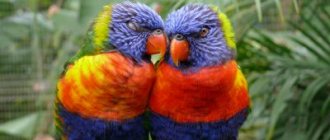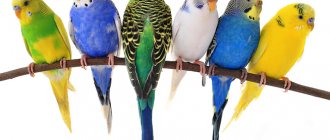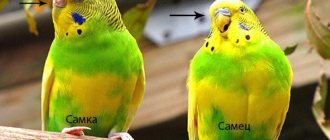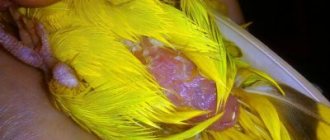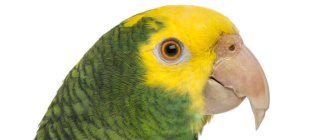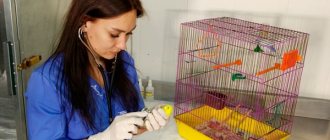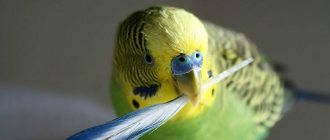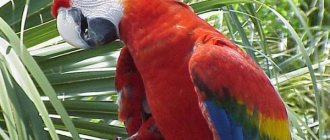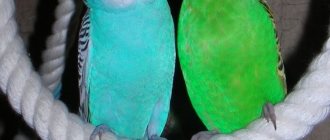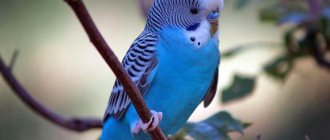If an egg appears in a cage where one budgerigar lives, it becomes a surprise for the owner. Questions arise: where did it come from, and whether a female budgerigar can even lay eggs without a male. In fact, such cases are not uncommon; almost every owner has encountered this at least once. Why a bird sometimes nests alone and whether this should be prevented, you will find out by reading the article.
Can a parrot lay an egg without a mate?
Maybe. But first, a little theory about reproduction in the bird world. There are birds of the brood type, for example, ducks, geese, chickens. Their reproductive system functions in such a way that they are ready to reproduce all year round and can lay eggs almost every day without much harm to health.
A parrot's ability to lay an egg without a mate
Nursing chicks does not require much sacrifice from the parents and is much easier due to the babies’ ability to feed on their own.
This process is completely different in nesting birds. This applies to both the cockatiel and the budgie. Their offspring are completely helpless after hatching. During the incubation period, birds experience a heavy load on the body and become vulnerable. And then they must devote themselves completely to the kids.
Therefore, they reproduce only under ideal conditions, when there is enough food, warmth, light and safety. Having a couple at this time fades into the background. In the wild, finding a male in your pack is not difficult; it is much more important to choose the right moment.
When kept at home, the pet’s body still works as nature intended. Under favorable conditions, the reproductive instinct dictates to the bird that it must take advantage of this chance. If the cockatiel laid an egg, then the life of the parrot is not bad. Igor Ignatenkov
Young animals
Newly hatched chicks are completely helpless. They bear little resemblance to their handsome parents. Their red body is devoid of fluff, and their eyes do not open. They don't stand on their paws. However, within 2 hours after birth they can feed. At first, the mother feeds them with goiter milk. The male brings grains to the female, and she, digesting them, feeds the offspring. After 2 weeks, both parents begin to feed the babies.
Nutrition
At this time, the diet of adults should consist of grain porridge, millet wheat, and boiled chicken eggs. For about 90 days, parrots work to incubate and feed their offspring. This is a long and difficult period in their life, so they must receive complete and balanced food.
What factors provoke egg production?
In the wild, cockatiels usually breed in spring and summer. This is due to a number of factors that stimulate sexual behavior in birds. Domesticated birds are affected by several other external stimuli that can cause egg production in the pet.
Provoking factors for egg laying
- Rich diet . An abundance of protein and fatty foods can provoke sexual behavior in birds. After all, these substances are primarily necessary for the formation of eggs and the growth of chicks. Products rich in these components include sunflower seeds, nuts, oilseeds, and animal feed. A varied diet and the presence of various tasty treats in large quantities also contribute to a favorable time for reproduction.
- Increasing daylight hours . In nature, the nesting period is a seasonal phenomenon. From the beginning of March, daylight hours become longer, which is a signal for birds to reproduce. At home, it can be increased thanks to artificial lighting, a TV or computer running in the evening.
- Ambient temperature. A warm, humid climate also signals the beginning of the mating season.
- Presence of neighboring birds. When kept together with other birds, the cockatiel may also begin to lay eggs. The incentive for this is the presence of a female sitting on the nest or an individual demonstrating mating behavior.
- Toys or mirror. In the absence of a partner, the cockatiel may mistake an object or its own reflection for it.
- Affectionate treatment of a person. By showing his love for the parrot in the form of stroking the plumage, the owner can provoke a desire in the bird to lay an egg. This is because these actions are similar to courtship among birds. If you finger the feathers on your pet’s head, stroke it on the back and under the wings, then the person’s hand can be regarded as a sexual partner.
Affectionate treatment of a person is perceived as a partner - Pet's emotional state. If your bird lays eggs, it means she feels completely safe and enjoys life. In conditions of constant stress, illness and lack of attention, the parrot is unlikely to think about procreation.
Ways to stop egg laying
If a female without a male lays eggs from time to time, the following reasons must be eliminated:
- Reducing lighting time to 10 hours a day. The bird can wake up at dawn and stay awake until nightfall. To prevent this from happening, cover the cage with a dark cloth in the evening. This way the parrot will gradually get used to the winter regime.
- Remove items for building nests from the cage: a house, a hammock, a hatch. Also, get rid of the mirror and toys to play with. Touching and stroking should be limited, as they cause tactile sensations similar to those experienced during pregnancy.
- Adapt the bird's diet by eliminating foods containing vitamin E (this component of vitamin E allows the body to reproduce). Sprouts should be removed from the menu. On the contrary, mineral foods should be given in increased quantities to compensate for calcium deficiency.
- Lower the room temperature. If this requires frequent airing, the birdcage should be removed or covered with a towel.
Distract your fluffy parrot from nesting with interesting activities: walks, bathing, games and communication with the owner. Little winged pets love attention and care and are happy to make contact. If you have time, training wolves and teaching speech is great. A bird that is not bored by itself becomes attached to a person. It does not need the company of other birds and is less subject to its natural instincts.
A female parrot can lay an egg without the participation of a male. He is encouraged by the good conditions created by the owner. Egg laying may be interrupted due to a slight disturbance in the bird's smooth movement.
What to do if your cockatiel lays an egg?
There is no need to panic, nothing bad has happened yet. This type of parrot has a predisposition to this phenomenon, but with the help of a number of actions the process can be controlled. However, the cockatiel’s frequent egg laying cannot be ignored, as its body becomes depleted and the pet’s lifespan may be reduced.
The owner has only two options for further action:
- leave the clutch and let the bird sit for the prescribed period;
- abruptly stop the process by getting rid of the eggs.
What to do with a laid egg
Caring for chicks
Small parrots are not born at the same time. Each of them has an egg crop (compacted area) on its beak, with which they pierce the shells.
At first, newborns are immobile, blind, and featherless. Parents feed the hatched parrots with a semi-digested mass called “goiter's milk”. In order for it to form in the female, she needs to eat sprouted grain. The general diet of the parent birds also needs to be enriched with fresh herbs and pieces of fruit.
When the babies are a week old, it is advisable to clean the nest and cage. If the female is against this, you can limit yourself to adding fresh sawdust with dry chamomile flowers.
This care should continue for 2 months until the chicks develop feathers and begin to attempt to fly out of the nest. From this time on, children are placed separately from their parents. The artificial nest is removed from the cage.
Important! If the female does not take care of the chicks, the owner of the birds must do so. You can place the “orphans” in the nest of another female, but so that the total number does not exceed 6. Then the mother will have enough warmth for all the children.
Is it possible to throw it away?
If no further breeding is planned
If you are firmly convinced that you will not buy a male bird, then you need to take the egg. The pet will protest, but this is a necessary measure. At the same time, take all the steps listed below to prevent re-laying.
Otherwise, the female will lay many more eggs, which will negatively affect her health. This is due to the loss of large amounts of calcium and other minerals, as well as the body’s energy expenditure.
During incubation, the pet eats little on its own, and the partner does not feed her. As a result, the parrot may get sick and even die. If the process is repeated many times, the life expectancy of the bird is reduced.
Carella laid an egg
To interrupt sexual behavior, take the egg and drive the pet away from the nesting site. Eliminate all factors that cause egg production in your cockatiel. After several such manipulations, the reproductive instinct fades away.
When a female lays a lot of eggs and no measures taken help stop this process, the individual can be sterilized surgically. But it is worth considering that not every veterinarian will cope well with this operation and the bird may not recover from it. Giving your pet a partner is considered a safer and more natural way to solve the problem.
Bird help options
It is best if your pet is assisted by an avian veterinarian. But if you can’t turn to him, there are safe ways to help your parrot lay an egg.
- Heat helps the oviduct muscles contract: place a heating pad under the bottom of the cage or place a bowl of hot water nearby. Attention! If your parrot is bleeding or has blood in its droppings, this should not be done.
- You can give a few drops of petroleum jelly (not to be confused with regular petroleum jelly) into the bird's beak from a pipette.
- Place Vaseline or vegetable oil (sunflower, apricot or peach) into the oviduct. First, it is sterilized: boiled for an hour in a water bath, then cooled. For application, use a pipette, a syringe without a needle, or a soft brush washed with chlorhexidine or miramistin.
- Handle the parrot very carefully so as not to crush the egg.
- If the bird does not resist, you can give it a light massage on the back and base of the wings. This helps relieve the pet of tension and stimulate contractions of the oviduct.
As soon as the egg is released, a chilled Stroud's solution (water, citric acid and soda) is instilled into the cloaca. If this does not happen, you will need urgent help from a specialist. The veterinarian will take x-rays to see the position and size of the egg and may give the bird oxytocin to stimulate contractions in the oviduct.
When a parrot is in critical condition, the doctor drains the egg to relieve pressure on the organs. The egg is pierced with a hollow needle, through which its contents are removed. Muscle contractions caused by the medicine help push the shell out, but sometimes surgery is also used.
There are often tips to push a stuck egg through with your hands, pressing on the abdomen. Under no circumstances do this if you have no experience. Shell fragments can cause serious injury and can be difficult to remove.
If you are going to breed pets
If you intend to buy a pair for a parrot and breed birds, you do not need to remove the egg. Corella usually carries and then incubates 5-7 of them for about three weeks. To prevent the female from wasting her energy, add plaster casts to the nest next to the real egg.
Allow the bird to serve its full term, and when none of them hatch after 21-22 days, the female will abandon the clutch. At the same time, she will retain her maternal instincts and become a good parent in the future. Without harm to health, laying eggs and hatching chicks is allowed no more than twice a year.
CORELLA LAYED AN EGG AT THE BOTTOM OF THE CAGE - panic!
Hatching eggs
The expectant mother carries the first egg for about 7–10 days. This is how much time passes from the moment of fertilization to laying. On the eve of the egg's appearance, you may notice rhythmic twitching of the bird's tail. In addition, she begins to pluck feathers near the anus.
Optimal conditions for pregnancy
According to statistics, the most fertile time for wavy cats is between 2 and 5 years of age. These are the parrots that lay the maximum number of eggs. Elderly females hatch no more than 5 eggs at a time.
A sufficient amount of calcium in the food of the expectant mother is of great importance. It is necessary for the formation of shells around embryos. Young females lay 8 or more eggs in one clutch.
Incubation
As soon as the female budgerigar has an egg, she immediately sits on the nest. From this moment on, the male begins to take care of feeding his wife. New eggs appear in parrots every day or at intervals of 24 hours.
Important! Until a week has passed from the moment the parrot's first egg appears, the clutch must not be touched! This can provoke the female to destroy the offspring.
Factors that influence how long a budgerigar incubates eggs:
- quality of bird keeping;
- number of eggs;
- wavy age;
- season.
Females sit on eggs for approximately 19–25 days. The expectant mother moves the clutch every 3-4 hours so that the embryos warm up evenly. The average temperature in the nest is approximately 38°C.
Interesting! Experts are confident that the number of days a budgerigar incubates eggs is directly related to the age of the couple. Young parents hatch faster.
Throughout the days that the female budgerigar incubates her eggs, she is removed from the clutch solely to empty her bowels. If the bird owner plans to clean something inside the cage at this time, he must act quickly and always wear gloves. No pungent odors should enter the parrots' house.
How to prevent laying without a male
Reduce contact with the bird
To prevent your female from exhibiting sexual behavior towards you, avoid physical contact with her. Do not pet your pet, especially on the back. If the bird mistook your hand for a partner, distract its attention by giving it a new interesting object.
Remove mirrors and toys from the cage
If the pet considers its reflection or toy to be an individual of the opposite sex, then this factor must be eliminated. Even if you have not noticed any corresponding interest in the bird, it is still better to remove these items from the cage for a while.
Adjusting the diet
First of all, give your parrot mineral supplements; you can dissolve calcium gluconate in the drink. Also hang a piece of chalk or a cuttlefish shell in the cage. This is necessary to replenish the substances expended on already laid eggs.
WHAT TO DO IF YOUR PARROT IS LAYING EGGS HOW TO STOP THE PROCESS
Eliminate sunflower seeds and oilseed grains from your diet. For the time being, reduce your feathered friend's intake of various treats to a minimum. Sprouts and animal feed should not be given.
Reducing daylight hours for birds
The signal for the start of reproduction is an increase in daylight hours to more than 12 hours. To suppress the sexual instinct, you need to reduce it to 8-10 hours, and in severe cases even to 6. To do this, cover the cage with thick fabric, and also exclude the use of artificial lighting in the room with the bird.
Temperature drop
The air temperature should not be too high. To ensure that the female stops laying eggs, stick to 18-20 degrees. A lower reading may cause your pet to catch a cold.
The female laid an egg without a male. For example, to the bottom of the cage.
Oviposition in parrots
Oviposition in parrots occurs as follows: after the birds mate, the yolk enters the female’s oviduct, where fertilization occurs. Next, the ready-made embryo is sent to the uterus, where the protein is deposited and the shell appears. After the finished egg has fully matured, it goes back and exits through the cloaca.
Can a female lay an egg without a male?
To breed parrots, of course, you need a pair. One partner cannot produce new life. However, many owners of female parrots noticed that, being the only pet, she carried eggs. The thing is that a happy bird develops too much maternal instinct, and she wants to continue her family.
The main reasons for this phenomenon are:
- daylight hours are too long;
- excess attention;
- lack of protein in the feed.
What to do: how to prevent masonry
In order to prevent masonry, it is necessary to exclude the possible causes that were indicated above, namely:
- Adjust daylight hours, reducing it to 8 hours. The owner must determine a schedule convenient for himself (when it will be possible to pay attention to this moment) and at the end of the parrot’s eight-hour wakefulness, cover the cage with a dark, dense cloth.
- Balance your diet. First of all, it is necessary to exclude all products that contain vitamin E, since this substance stimulates the female’s body to procreate.
- Also, as an additional method, you should temporarily avoid touching the animal , since a strong bond between a pet and a person can also stimulate reproduction.
About the secret
The mating process in parrots is preceded by incredible mating games. The male's arsenal includes dancing on a perch, mating, and peculiar “kisses” on the beak. At the same time, he can frantically knock his beak against everything in the cage. The apogee of courtship is joint feeding. When the female has accepted the male's treats, which he regurgitates during his advances, consider the job done.
Also, during the courtship process, the birds mate several times a day. To do this, the female crouches to the floor, and the male climbs onto her back, as if enveloping the “bride” with wings and fertilizes her. About a week after these actions you can expect the first egg. The female, who is about to lay an egg, becomes extremely playful, and her tail performs rhythmic pendulum movements. You can watch the entire love process of parrots in the video below!

